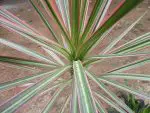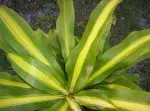This post contains affiliate links. If you buy something from one of our links we may earn a commission. Thanks
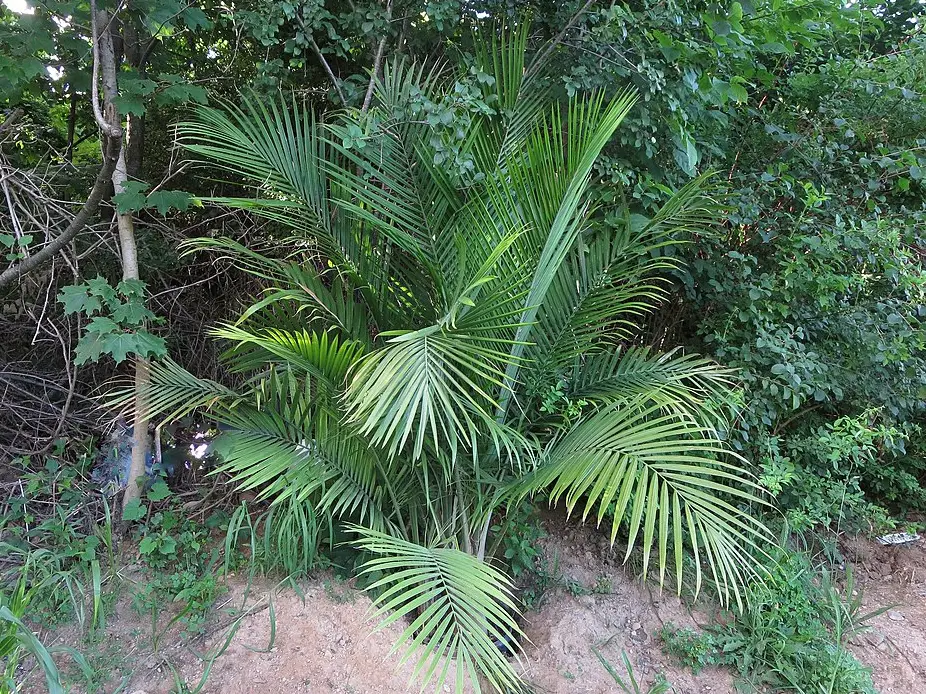
Looking to keep your majesty palm thriving indoors? Our guide covers all aspects of majesty palm care indoors, from watering to pruning and more!
Majesty Palm (Ravenea Rivularis) care indoors revolves around providing bright, indirect light, maintaining a consistent watering schedule to keep the soil moist but not waterlogged, and ensuring a warm, humid environment.
Regular fertilization every three months during the growing season with a slow-release fertilizer, and repotting every 2-3 years will further contribute to a healthy and thriving Majesty Palm indoors.
Hey there, plant lovers! Are you looking for an easy-to-care-for indoor plant that brings a tropical vibe into your home?
Look no further than the majesty palm! These beautiful plants are not only visually stunning but also offer numerous benefits for your indoor space.
That’s where Majesty Palm Care Indoors comes in! In this majesty palm care guide we’ll take you through everything you need to know about caring for your majesty palm, from watering to pruning and everything in between. So, let’s get started!
Majesty Palm Quick Facts
| Mature Height: | 8-10 ft Indoors 10-20 ft Outdoors |
| Mature Width: | 4-5 ft Indoors 10-18 ft Outdoors |
| Sunlight: | Partial |
| Growth Rate: | Fast |
| Botanical Name: | Ravenea rivularis |
| Grows Well In Zones: | 4-11 patio / 9-11 outdoors |
You can buy your Majesty Palm here
What Is A Majesty Palm?
The Majesty Palm, scientific name Ravenea rivularis, is in the Arecaceae family and is a popular tropical plant that’s native to Madagascar.
It’s known for its tall, slender trunk and lush green fronds that can reach up to 8 feet in length.
In recent years, majesty palm trees become increasingly popular as an indoor plant due to their stunning appearance and easy-to-care-for nature.
The majestic palm is an excellent addition to any home, office, or commercial space, making it a versatile and practical choice for plant enthusiasts everywhere.
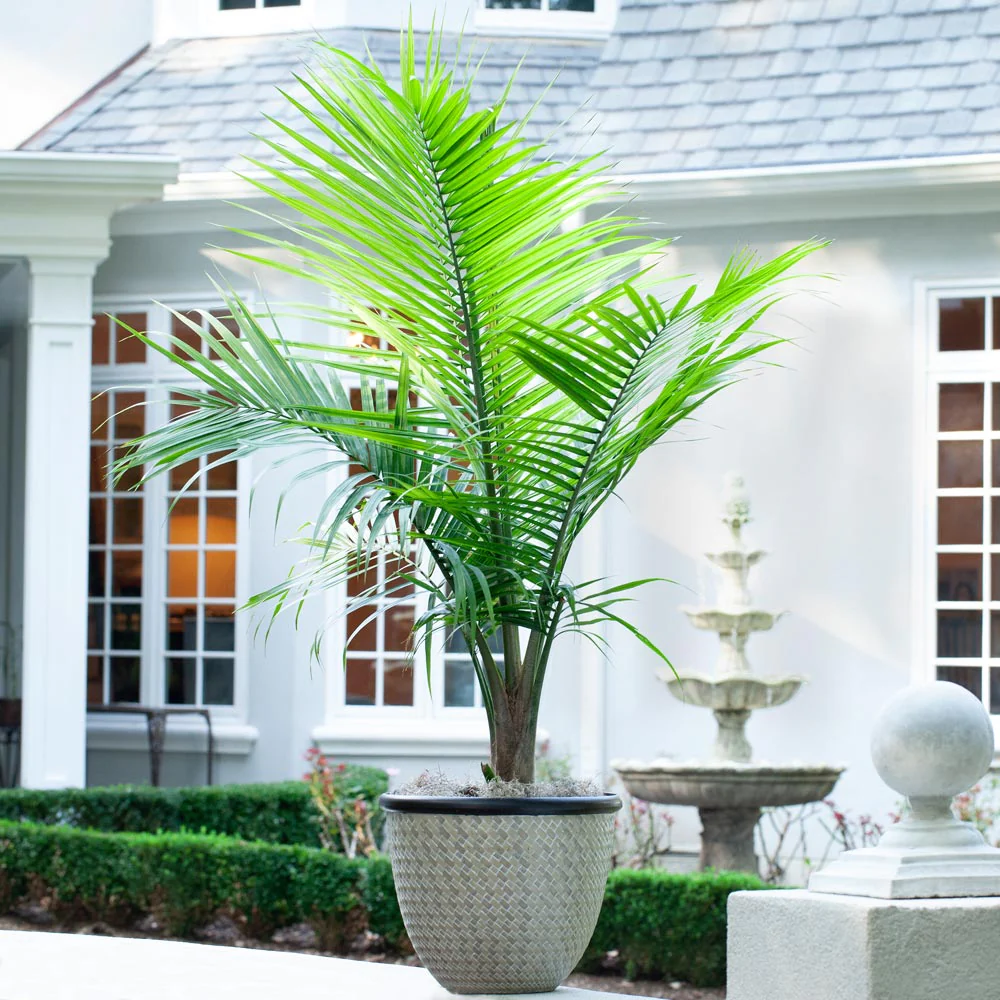
Majesty Palm Indoor Benefits
Majesty palm plants are not only aesthetically pleasing but also offer several benefits for indoor spaces.
In this section, we will discuss the various advantages of having a majesty palm in your home.
From improving air quality to boosting mood and reducing stress, there are plenty of reasons to consider this beautiful plant as a valuable addition to your indoor decor.
Majesty palms offer several benefits when kept as indoor plants.
They act as natural air purifiers and help to remove harmful toxins from the air, such as formaldehyde and benzene, which are commonly found in household products and synthetic materials like carpets and furniture.
Majesty palms are also great at regulating humidity levels, which is particularly useful during dry winter months.
In addition, they help to reduce stress and boost mood, making them an ideal choice for indoor spaces.
Having a majesty palm in your indoor environment can positively impact your overall health and well-being
The reduction in harmful toxins can lead to better air quality, which can reduce the risk of respiratory problems and improve the quality of sleep.
By helping to regulate humidity levels, the plant can also reduce skin dryness and irritation, as well as improve overall comfort in the home.
In addition, the plant’s calming effect can help reduce stress and improve mood, leading to a more peaceful and relaxing living environment.
Overall, the benefits of keeping a majesty palm indoors can make a significant positive impact on your health and well-being.
What’s Covered In Majesty Palm Care Indoors
In this post, we’ll cover everything you need to know about caring for your majesty palm indoors.
We’ll start by discussing the ideal lighting conditions for your plant, including the amount of sunlight it needs and how to prevent sunburn.
We’ll also explore the watering requirements for your majesty palm and offer tips on how to keep the soil moist without overwatering.
Additionally, we’ll cover topics such as humidity, temperature, and repotting, as well as common pests and diseases that may affect your plant.
By the end of this post, you’ll have all the information you need to keep your majesty palm healthy and thriving for years to come.
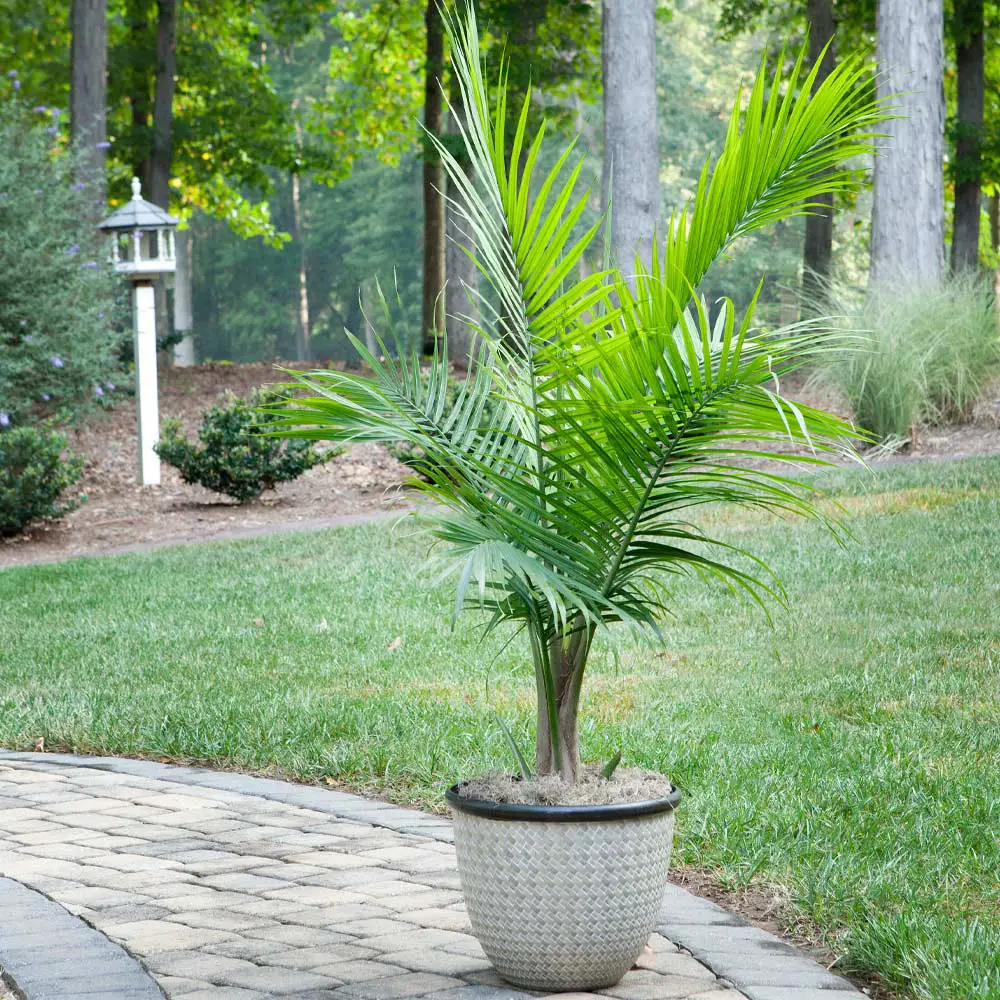
Majesty Palm Care Indoors Light Requirements
Welcome to the section on light requirements for your majesty palm! Like all plants, the majestic palm requires a certain amount of light to thrive.
But figuring out the right amount of light can be tricky, especially if you’re not familiar with the plant’s needs.
In this section, we’ll go over everything you need to know about providing your majesty palm with the right amount of light, including the ideal placement of your plant, how to prevent sunburn, and the importance of proper shading.
So, let’s get started and learn how to keep your majestic palm healthy and happy with the right amount of light!
The Majesty Palm needs bright indirect light
Majesty palms require bright, indirect light to grow and thrive indoors. Majesty palms like 6-8 hours of bright light so a sunny window is a great place for them.
Direct sunlight can be too intense for this plant, leading to sunburn and other issues.
On the other hand, too little light can cause the plant to become leggy and weak. Ideally, the plant should receive at least 6-8 hours of indirect sunlight each day.
Placing your majesty palm near a bright, east-facing window can provide the perfect balance of light and protection.
Finding the right location in the home
When finding a location for your majesty palm, consider the plant’s needs and the conditions in your home.
As mentioned, an east-facing window can be an ideal location, as it provides bright, indirect light without the intensity of the midday sun.
If you don’t have an east-facing window, try placing your plant in a spot that gets filtered light, such as a room with a sheer curtain by a south-facing window.
Avoid placing your plant near drafty windows or air conditioning vents, as this can cause stress and damage to the plant.
How to adjust light levels for changing seasons
As the seasons change, it’s important to adjust the light levels for your majesty palm.
During the summer months, the sun is stronger, and your plant may require more shade. You can use sheer curtains, blinds, or other shading devices to reduce the amount of direct sunlight your plant receives.
During the winter months, the sun is weaker, and your plant may require more light.
Consider moving your plant to a brighter location where it will get enough light or supplementing it with artificial light.
You can use LED grow lights, or fluorescent lights to provide the extra light your plant needs to thrive.
In summary, providing the right amount of light for your majestic palm is essential for its health and growth.
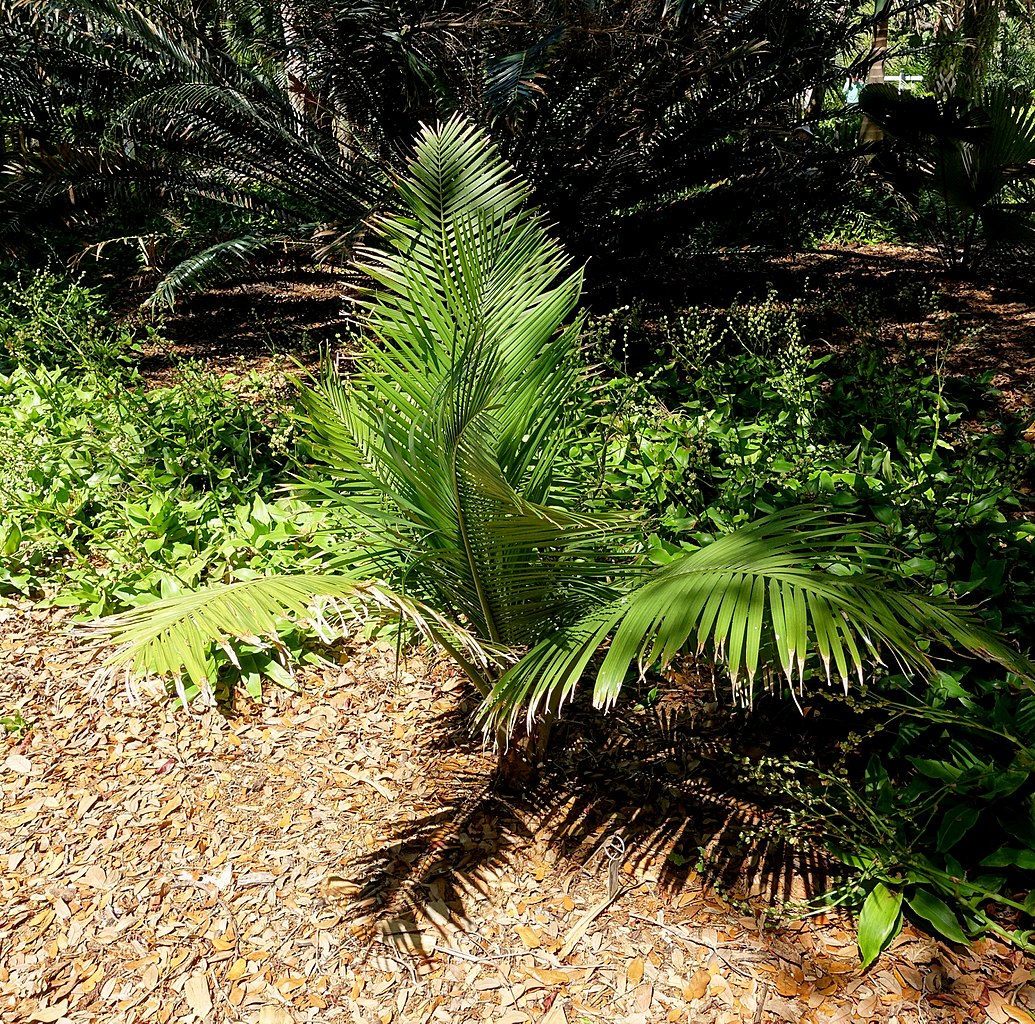
Watering and Humidity
Welcome to the section on watering and humidity for your majesty palm. Proper watering and humidity levels are crucial for the health of your majestic palm, but it can be a bit tricky to get it just right.
Overwatering can lead to root rot, while underwatering can cause the leaves to turn brown and wilt.
In this section, we’ll cover everything you need to know about watering your plant, including how often to water it, the type of water to use, and the importance of maintaining proper humidity levels.
So, let’s get started and learn how to keep your majestic palm healthy and hydrated!
Regular watering to keep the soil moist but not soggy
Majesty palms need to be watered regularly to keep the soil moist but not soggy. Soggy soil can cause root rot, which can be fatal to your plant.
On the other hand, letting the soil dry out completely can cause the leaves to turn brown and fall off.
It’s essential to maintain a consistent watering schedule to keep your plant healthy. One helpful tip is to check the soil’s moisture level regularly, so you know when it’s time to water.
You can use a moisture meter or stick your finger into the soil to determine if it’s time for watering.
Watering schedule and frequency
Majesty palms need to be watered when the top inch of soil feels dry to the touch.
The frequency of watering will depend on several factors, including temperature, humidity, and lighting conditions in your home.
As a general rule of thumb, you should water your plant once a week during the summer months and once every ten days during the winter months.
However, it’s important to adjust the watering frequency based on the plant’s needs.
Be careful not to overwater or underwater, as both can be detrimental to your plant’s health.
How to increase humidity for optimal growth
Majesty palms are native to tropical regions and thrive in high humidity environments.
However, most homes have dry air, especially during the winter months which can cause the plant’s leaves to turn brown and dry out.
To increase the humidity level, you can place a humidifier near the plant or use a pebble tray.
A pebble tray is a shallow tray filled with pebbles and water. As the water evaporates, it creates a humid microclimate around the plant.
Another way to increase humidity is by misting the leaves with water. This will help keep the leaves hydrated and prevent them from drying out.
Why can tap water be bad and what to use instead
Tap water can be bad for plants due to the presence of chemicals such as chlorine and fluoride, which can be harmful to the roots and cause leaf burn.
Additionally, tap water may contain minerals and salts that can accumulate in the soil over time and affect the pH balance, leading to nutrient deficiencies and other problems.
One alternative to tap water is to use filtered or distilled water. These types of water have had the harmful chemicals and minerals removed, and are generally better for plant growth.
Another option is to collect rainwater, which is free of chemicals and naturally balanced for plant growth.
In conclusion, watering and humidity are critical factors in maintaining the health and growth of your majesty palm.
By following these tips and staying consistent with your watering schedule, you can help your plant thrive and enjoy the lush tropical foliage it provides.
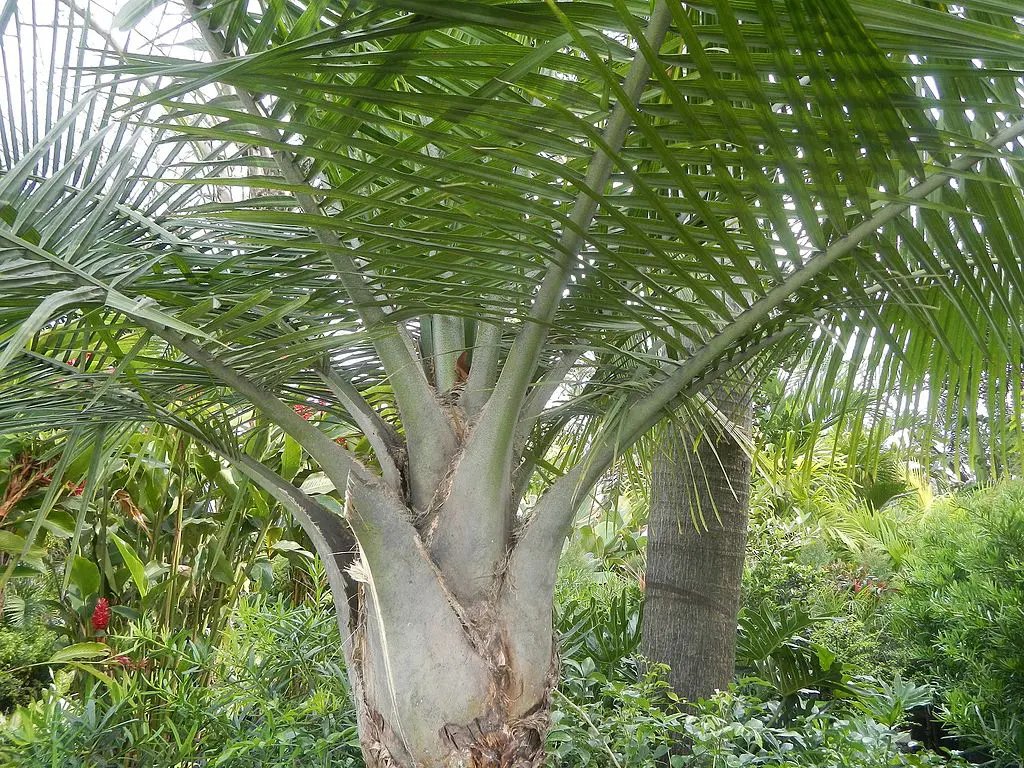
Fertilizer and Soil
Welcome to the section on fertilizer and soil for your majestic palm. Proper soil and fertilizer are crucial for the growth and health of your plant.
The right soil will provide essential nutrients and promote healthy root development, while the correct fertilizer will provide your plant with the necessary nutrients to thrive.
In this section, we’ll cover everything you need to know about soil and fertilizer for your majestic palm, including the type of soil to use, how to repot your plant, and the best fertilizer for optimal growth.
It is also important to use a pot with drainage holes in the bottom of the pot. So, let’s get started and learn how to keep your majestic palm healthy and thriving!
The importance of a well-draining soil mix
When it comes to the soil mix for your majestic palm, it is essential to ensure it is well-draining.
Majesty palms prefer moist soil, but they are susceptible to root rot if the soil remains too wet.
A well-draining soil mix will allow water to flow through and prevent waterlogging, which can cause the roots to rot.
Recommendations for the best soil types
The best soil types for majestic palms are those that are rich in organic matter and are able to hold moisture without becoming waterlogged.
A good soil mix should contain a blend of peat moss, perlite, and vermiculite. You can also add some sand to the mix to ensure good drainage.
The Case For Using Coco Coir Vs Peat
A coco coir and perlite mix is superior to soil mix that contains a blend of peat moss, perlite, and vermiculite And here’s why:
Coco coir and perlite mix can be a superior alternative to the traditional soil mix for majestic palms, as it provides better drainage and aeration, while also being a more sustainable and environmentally friendly option.
Coco coir, which is derived from coconut husks, is a renewable and biodegradable material that is often used as a soil amendment.
It has a high water retention capacity and excellent air porosity, which makes it an excellent medium for plant growth.
Perlite, on the other hand, is a volcanic mineral that has been processed into lightweight, white, and porous granules that improve soil drainage and aeration.
Peat moss, vermiculite, and perlite are the most commonly used components in traditional soil mixes for majestic palms.
Peat moss, which is harvested from bogs, has a high water-holding capacity and can improve soil structure.
Vermiculite is a lightweight and absorbent mineral that is often used to improve soil aeration and moisture retention. Perlite, as mentioned earlier, is used to improve drainage and aeration.
While these traditional soil mix components can be effective for growing majestic palms, they do have some drawbacks.
Peat moss is not a renewable resource, and its extraction can cause significant damage to fragile ecosystems.
The harvest of sphagnum peat destroys our wetlands and it can take thousands of years for them to regrow.
Vermiculite, on the other hand, may contain asbestos-like fibers, which can be harmful to human health.
Perlite is a more environmentally friendly and safer option, but it can be less effective in retaining moisture compared to coco coir.
In summary, a coco coir and perlite mix can be a superior alternative to traditional soil mixes for growing majestic palms due to its excellent drainage and aeration properties, its renewability, and its eco-friendliness.
However, each plant has its own unique needs, and you should choose a soil mix based on your plant’s specific requirements and your own preferences.
The benefits of fertilization and the appropriate frequency
Fertilization is essential for the healthy growth and development of your majestic palm.
Fertilizers provide your plant with essential nutrients that may not be present in the soil.
A slow-release fertilizer is best for majesty palms, and it should be applied every three months during the growing season, which is usually from spring to early fall.
Fertilizing during the winter months is not necessary since the plant is not actively growing during this period.
When fertilizing your majestic palm, make sure to follow the instructions on the label to avoid over-fertilizing, which can damage your plant.
With the right soil mix and regular fertilization, your majestic palm will thrive and look stunning in your home.
The best way to fertilize your majestic palm is with slow-release fertilizer spikes. They are much easier to use than a liquid fertilizer.
The use of tree spikes will take the guesswork out of fertilizing. Here is what I recommend for  fertilizing your majesty palm.
fertilizing your majesty palm.
I recommend using Jobes Organics fertilizer spikes.
They are easy to use and last for 2-3 months.
They are designed for container-grown citrus but will work great for palms too.
Using 2 spikes for a 12-inch pot or 3 for an 18-inch pot takes the guesswork out of fertilizing.
They provide a 3-5-5 fertilizer blend along with micronutrients and beneficial bacteria.
Pruning and Repotting
Majesty palms are a popular indoor plant, known for their lush, tropical appearance.
To keep your plant looking its best, pruning and repotting are essential tasks that should be done periodically.
Pruning can help to keep your plant healthy and maintain its shape while repotting ensures that your plant has enough space to grow and receives the necessary nutrients.
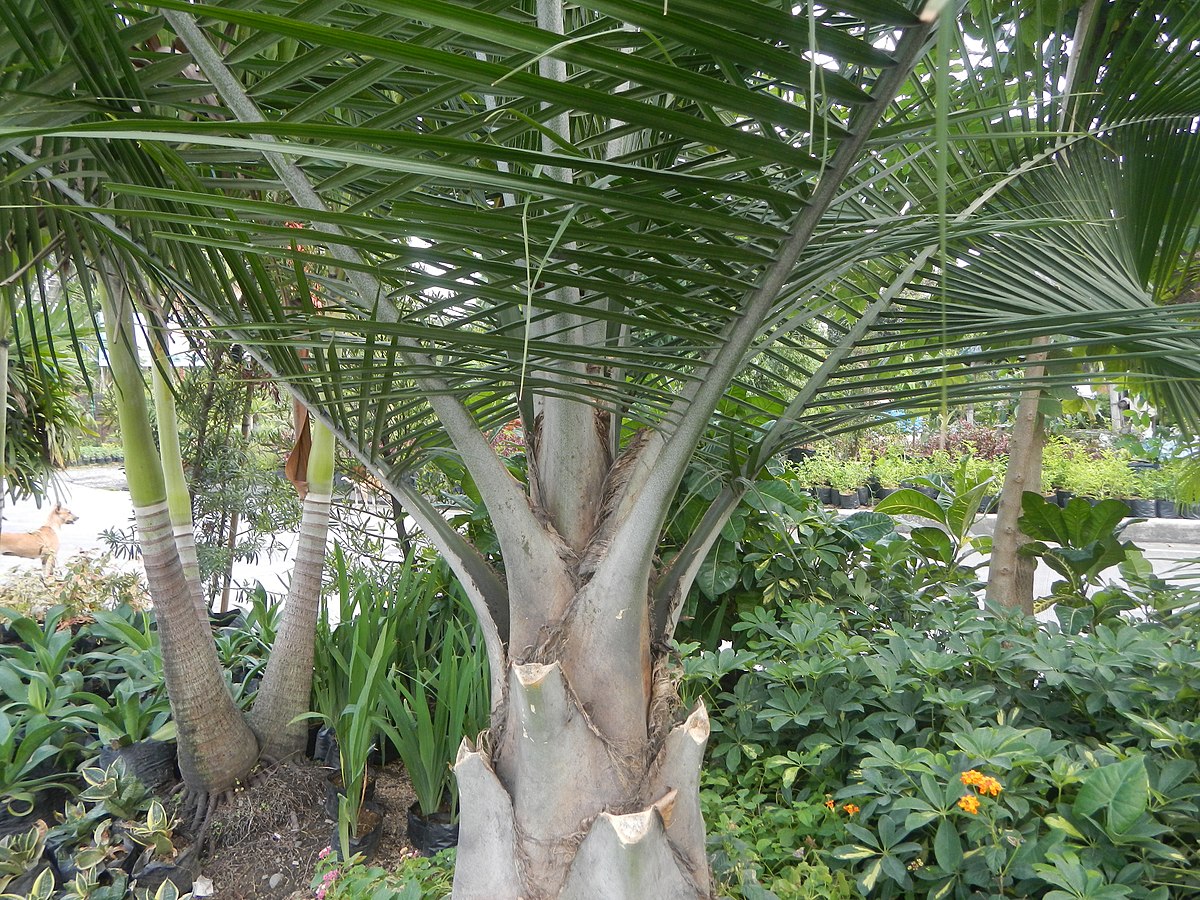
In this section, we will discuss the best techniques for pruning and repotting your majestic palm to ensure its longevity and vibrancy.
The need for regular pruning and trimming
Regular pruning and trimming of your Majesty palm are necessary to keep the plant healthy and looking its best.
This involves removing yellow or brown leaves, trimming away any dead fronds, and cutting back any diseased or damaged areas of the plant.
Regular pruning can also help to prevent overcrowding, which can lead to poor air circulation and an increased risk of pests and diseases.
Tips for pruning to maintain its shape and size
When pruning your Majestic palm, it’s important to keep in mind the desired shape and size of the plant.
To maintain its natural appearance, start by removing any damaged or discolored leaves.
Next, trim away any dead or yellowing fronds by cutting them off at the base and take care not to cut into the main stem of the plant.
When and how to repot the plant to ensure continued growth
Repotting your Majesty palm is essential to ensure continued growth and health.
When the plant has outgrown its current pot, it’s time to transplant it into a larger container.
It’s recommended to repot your plant every 2-3 years. To repot, gently remove the plant from its current pot, being careful not to damage the roots.
Remove any dead or damaged roots from the root ball and place the plant in a new pot with a fresh mix of soil.
Make sure to choose a pot that is slightly larger than the previous one, with good drainage.
Place it in the center of the new pot and begin filling in around the roots with fresh soil, hold it up if necessary, and plant it at the same depth it was growing at before
Water the plant thoroughly to remove any air pockets and allow it to settle into its new home.
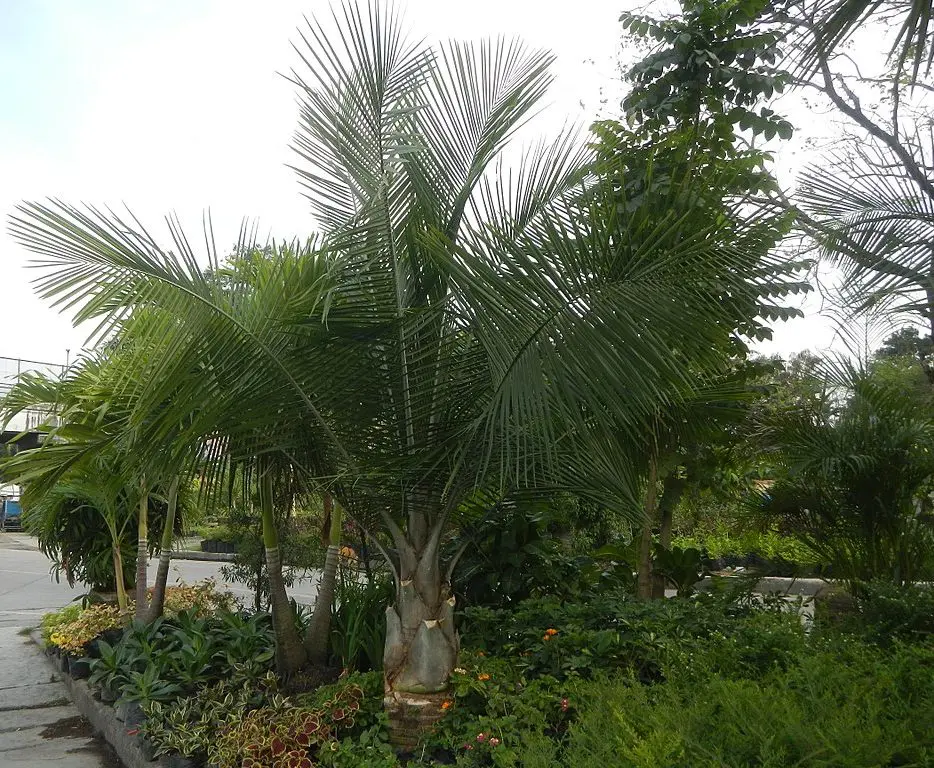
Troubleshooting
A Majesty palm can be a beautiful and rewarding addition to any indoor space, but like any plant, it can also experience issues and challenges.
In this section, we’ll cover some of the most common problems that Majesty palm owners may encounter and provide solutions to help troubleshoot and overcome these issues.
From yellowing leaves to pest infestations, we’ll provide tips and advice to keep your Majesty palm healthy and thriving.
Common problems with Majesty Palms
Majesty palms are a hardy plant, but they can still be susceptible to certain problems.
Some common issues include yellowing leaves, browning leaf tips, pest infestations, and root rot.
It’s important to keep an eye out for any signs of distress, so you can address the issue before it becomes too severe.
Tips for identifying and treating pests and diseases
Pests such as spider mites, mealybugs, and scale insects can be a major problem for Majesty palms.
These pests can cause damage to the leaves and sap the plant’s energy. If you notice pests on your plant, it’s important to act quickly to prevent them from spreading.
You can use insecticidal soap or neem oil to treat pest infestations.
Pests
Spider mites can be a common problem for Majesty palms and can cause yellowing leaves and webbing on the plant.
To address this, you can use insecticidal soap or neem oil to treat the infestation.
By being proactive and keeping an eye out for any signs of distress, you can ensure your Majesty palm stays healthy and beautiful for years to come.
Mealybugs and scale insects are common pests that can infest majesty palms, as well as many other houseplants.
They both feed on the sap of the plant and can cause stunted growth, yellowing leaves, and even death if left untreated.
Mealybugs are small, soft-bodied insects that are covered in a white, cottony substance that looks like tiny bits of cotton.
They can usually be found on the undersides of leaves or in the crevices where the leaves meet the stem.
Scale insects, on the other hand, are hard-shelled and can range in color from brown to black.
They can also be found on the undersides of leaves, as well as on stems and other parts of the plant.
To treat mealybugs or scale insects, start by removing as many of them as possible by wiping them away with a soft cloth or cotton swab dipped in rubbing alcohol.
Another approach is to use a neem oil or insecticidal soap, which suffocates the insects by clogging their breathing pores.
Be sure to repeat the treatment a few times to make sure you get all the bugs, as they can be quite resilient.
For these to be effective it is important to thoroughly spray the entire plant because the spray must make direct contact to kill the pests.
It’s also a good idea to isolate the infected plant to prevent the infestation from spreading to other plants.
Preventing mealybugs and scale insects is key to keeping your majesty palm healthy.
Make sure to regularly inspect your plant for any signs of infestation and keep it clean by wiping down the leaves with a damp cloth or sponge.
You can also use insecticidal soap as a preventative measure, but be sure to follow the instructions carefully to avoid damaging the plant.
Diseases
Diseases such as fungal infections can also occur, especially if the soil is too damp or if the plant is overwatered.
To avoid these problems, make sure your Majesty palm is planted in a well-draining soil mix and that you’re not overwatering it.
If you notice any signs of fungal infection, you can treat it with a fungicide.
How to address common issues such as yellowing leaves, root rot
Yellowing leaves can be a sign of overwatering or underwatering, so it’s important to find the right balance.
If you’re overwatering your plant, the soil may be too damp, and the roots may be rotting.
To address this, cut back on watering and make sure the soil has a chance to dry out between waterings.
If you’re underwatering, the leaves may become dry and brown around the edges. To address this, make sure you’re watering your plant regularly and that it’s getting enough moisture.
Root rot can be caused by overwatering, which can lead to the roots becoming waterlogged and eventually rotting.
To prevent root rot, make sure your Majesty palm is planted in a well-draining soil mix and that you’re not overwatering it.
How Big Do Majesty Palms Get Indoors?
Majesty palms are a popular choice for indoor plant enthusiasts due to their lush foliage and tropical look.
However, before bringing a majesty palm into your home, it’s important to understand its growth habits and size potential.
In this section, we’ll discuss how big majesty palms can get when grown indoors, and what factors can affect their growth.
Whether you’re a new or seasoned plant owner, understanding the growth potential of your majesty palm can help you better care for this beautiful plant.
A majesty palm is a popular indoor plant that can add a touch of tropical flair to any space.
If you’re considering adding one to your collection, it’s essential to know how big they can get indoors.
Majesty palms are known for their relatively slow growth, but they can still reach impressive heights if given the proper care.
In this section, we’ll discuss the average size of a mature majesty palm grown indoors and the various factors that can influence its growth.
Majesty Palm Indoor Size
A mature majesty palm can grow up to 10-12 feet tall indoors, with fronds that can span up to 8 feet wide.
However, it is a slow grower and this growth can take several years to achieve, and you’ll need to be patient as it slowly grows.
Most majesty palms home growers purchase at a local nursery or garden centers are around 3-5 feet tall, and it can take several years for them to reach their full height potential.
Factors that Influence Growth
Several factors can affect the growth of a majesty palm indoors. One of the most significant factors is the amount and quality of light it receives.
Majestic palms need bright, indirect light, and if they don’t receive enough of it, their growth can slow down.
Additionally, proper watering and fertilization are critical to ensure optimal growth. Majesty palms need to be watered regularly, and their soil should be well-draining to prevent root rot.
Fertilizing them every few months can also help promote healthy growth.
In summary, understanding how big a majesty palm can get indoors is essential for proper care. With the right care and patience, your majestic palm can grow to be an impressive addition to your indoor plant collection.
If you are looking for smaller palm trees to grow indoors you can consider these:
Sago Palm
Parlor Palm Chamaedorea elegans
Majesty Palm Temperature Range
Majesty palms are a popular indoor plant, but they require specific environmental conditions to thrive.
In addition to providing the right amount of light and water, it’s important to keep room temperatures within a specific range.
In this section, we’ll discuss the optimal temperature range for majesty palms, and provide tips for keeping your plant healthy and happy.
The best temperature range for growing majesty palms indoors
Majesty palms are tropical plants that thrive in warm, humid conditions in their natural habitat.
As such, it’s important to ensure the temperature in your home is suitable for their growth.
In this section, we will discuss the ideal temperature range for growing majesty palms indoors, as well as how to avoid damage caused by cold drafts or extreme heat.
Additionally, we’ll explore the possibility of moving your palm outside during the summer months, including which USDA zones are suitable for outdoor growth and what low temperatures to avoid.
By the end of this section, you’ll have a good understanding of how to maintain the optimal temperature for your majesty palm’s growth and well-being.
How to adjust temperature levels to prevent damage from cold drafts or extreme heat
Majesty palms thrive in warm, tropical environments and generally prefer temperatures between 60 and 80 degrees Fahrenheit.
As indoor plants, they can adapt to a wider range of temperatures, but it’s important to keep them away from cold drafts or areas with extreme temperature changes, which can damage their leaves and slow their growth.
One way to maintain a consistent temperature for your majesty palm is to avoid placing it near air conditioning or heating vents that can cause sudden temperature shifts.
Moving it outside in summer
During the summer, majesty palms can be moved outside to a shady spot where they can enjoy natural light and fresh air.
If you live in a USDA zone that allows for outdoor growth, you can plant your majesty palm in a well-draining soil mix and fertilize it regularly.
However, it’s important to note that these plants are sensitive to low temperatures, and frost or freezing temperatures can damage or kill them.
Be sure to bring your majesty palm indoors before the temperature drops below 55 degrees Fahrenheit.
With the right care and attention, your majesty palm can thrive both indoors and outdoors, adding beauty and natural air purification to your home or garden.
USDA hardiness zones and low temperatures for outdoor plants
Majesty palms are native to Madagascar and prefer warm, tropical climates. In the United States, they can be grown outdoors in USDA zones 9b to 11, which include areas with minimum average temperatures ranging from 25 to 40 degrees Fahrenheit (-3.9 to 4.4 degrees Celsius).
In these zones, majesty palms can thrive when planted in well-draining soil and provided with ample sunlight and water but still may occasionally need frost protection.
Majesty Palm FAQ
Majesty Palms are a sought-after indoor plant, bringing a tropical aesthetic to homes and offices.
However, like any plant, they have their specific care needs and common questions surround their maintenance.
Here are some FAQs to help you get acquainted with the care and nurturing of Majesty Palms indoors:
Q. How often should I water my Majesty Palm indoors?
A. Water your Majesty Palm when the top inch of soil feels dry to the touch. Typically, once a week during summer and once every ten days in winter should suffice. However, this may vary depending on the environmental conditions in your home.
Q. What type of soil is best for Majesty Palms?
A. A well-draining soil mix rich in organic matter is ideal. A mix of coco coir and perlite can be a superior choice due to its excellent drainage, aeration, and environmental sustainability compared to traditional peat moss-based mixes.
Q. How much sunlight does a Majesty Palm need?
A. Majesty Palms thrive in bright, indirect light. They prefer a sunny spot, and east-facing windows are often ideal. They require around 6-8 hours of bright, indirect sunlight daily to maintain healthy growth.
Q. What is the ideal temperature for Majesty Palms indoors?
A. Majesty Palms prefer a warm environment with temperatures ranging between 60 and 80 degrees Fahrenheit. They are sensitive to cold drafts and extreme temperature changes, so it’s essential to maintain a consistent temperature to keep them thriving.
Final Thoughts
In conclusion, growing a majestic palm indoors can be a rewarding and fulfilling experience for any plant enthusiast.
With its towering fronds, the majestic palm is not only visually stunning but also offers numerous benefits, such as air purification and stress reduction.
By following the proper care and maintenance instructions, including ensuring the right light, water, and soil conditions, pruning, and treating common pests and diseases, anyone can successfully grow a healthy and vibrant majestic palm in their home.
Remember that each plant is unique, and it may take some trial and error to find the perfect balance, but with time and patience, anyone can enjoy the lush, tropical ambiance of a majestic palm in their home.
Key points covered in the post
After covering a variety of important topics related to growing and caring for majesty palms, it is important to summarize the key points.
This post has discussed the popularity of majesty palms as indoor plants, the benefits of having them indoors, the light requirements, watering and humidity needs, soil and fertilizer requirements, pruning and repotting, troubleshooting common problems, the benefits to health and well-being, the size of mature majesty palms, and the ideal temperature range for growing them indoors.
Each of these points has provided valuable information for anyone looking to care for a majesty palm, and summarizing them can help readers retain and remember the key takeaways.
Give growing Majesty Palms indoors a try
Growing a majesty palm indoors can be a rewarding experience, bringing a touch of tropical beauty and improving the air quality of your home.
With the right care and attention, these majestic plants can thrive and grow into stunning specimens that add a touch of natural elegance to any room.
By following the tips and recommendations outlined in this post, you can feel confident in your ability to provide optimal growing conditions for your majesty palm.
Don’t be afraid to experiment and make adjustments along the way, and be sure to share your successes and challenges with fellow plant enthusiasts.
With a little effort and patience, you can enjoy the many benefits of growing a majesty palm in your home for years to come.
You Can Buy Your Majesty Palm here
Read more: Indoor Palm Tree Care: Complete Guide For Beginners


